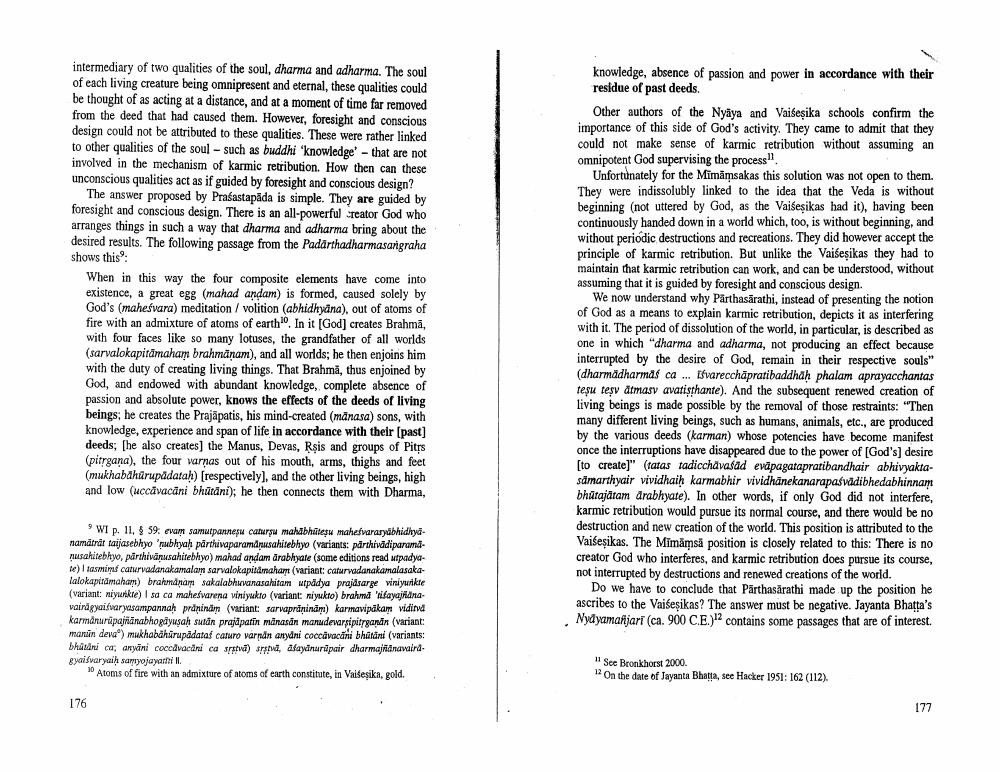Book Title: Mimamsa Versus Vaisesika Author(s): Johannes Bronkhorst Publisher: Johannes Bronkhorst View full book textPage 4
________________ intermediary of two qualities of the soul, dharma and adharma. The soul of each living creature being omnipresent and eternal, these qualities could be thought of as acting at a distance, and at a moment of time far removed from the deed that had caused them. However, foresight and conscious design could not be attributed to these qualities. These were rather linked to other qualities of the soul - such as buddhi 'knowledge' - that are not involved in the mechanism of karmic retribution. How then can these unconscious qualities act as if guided by foresight and conscious design? The answer proposed by Prasastapāda is simple. They are guided by foresight and conscious design. There is an all-powerful creator God who arranges things in such a way that dharma and adharma bring about the desired results. The following passage from the Padarthadharmasangraha shows this: When in this way the four composite elements have come into existence, a great egg (mahad andam) is formed, caused solely by God's (maheśvara) meditation / volition (abhidhydna), out of atoms of fire with an admixture of atoms of earth". In it (God) creates Brahma, with four faces like so many lotuses, the grandfather of all worlds (sarvalokapitāmaham brahmanam), and all worlds; he then enjoins him with the duty of creating living things. That Brahma, thus enjoined by God, and endowed with abundant knowledge, complete absence of passion and absolute power, knows the effects of the deeds of living beings, he creates the Prajapatis, his mind-created (manasa) sons, with knowledge, experience and span of life in accordance with their (past) deeds; she also creates) the Manus, Devas, Rşis and groups of Pitrs (pitrgana), the four varnas out of his mouth, arms, thighs and feet (mukhabahurupddatal) (respectively), and the other living beings, high and low (wccdvacáni bhärdni); he then connects them with Dharma, knowledge, absence of passion and power in accordance with their residue of past deeds. Other authors of the Nyaya and Vaibesika schools confirm the importance of this side of God's activity. They came to admit that they could not make sense of karmic retribution without assuming an omnipotent God supervising the process." Unfortunately for the Mimamsakas this solution was not open to them. They were indissolubly linked to the idea that the Veda is without beginning (not uttered by God, as the Vaišeşikas had it), having been continuously handed down in a world which, too, is without beginning, and without periodic destructions and recreations. They did however accept the principle of karmic retribution. But unlike the Vaišeşikas they had to maintain that karmic retribution can work, and can be understood, without assuming that it is guided by foresight and conscious design. We now understand why Parthasārathi, instead of presenting the notion of God as a means to explain karmic retribution, depicts it as interfering with it. The period of dissolution of the world, in particular, is described as one in which "dharma and adharma, not producing an effect because interrupted by the desire of God, remain in their respective souls" (dharmadharmas ca... Efvarecchāpratibaddhah phalam aprayacchantas teşu teşv atmasv avaristhante). And the subsequent renewed creation of living beings is made possible by the removal of those restraints: "Then many different living beings, such as humans, animals, etc., are produced by the various deeds (karman) whose potencies have become manifest once the interruptions have disappeared due to the power of God's) desire [to create)" (tatas tadicchávasad evāpagatapratibandhair abhivyaktasdmarthyair vividhaih karmabhir vividhänekanarapaśyddibhedabhinnam bhūtajātam drabhyate). In other words, if only God did not interfere, karmic retribution would pursue its normal course, and there would be no destruction and new creation of the world. This position is attributed to the Vaišeşikas. The Mimamsk position is closely related to this: There is no creator God who interferes, and karmic retribution does pursue its course, not interrupted by destructions and renewed creations of the world. Do we have to conclude that Pārthasarathi made up the position he ascribes to the Vaišeşikas? The answer must be negative. Jayanta Bhatta's Nydyamafjarl (ca. 900 C.E.)" contains some passages that are of interest. WIP. II, 59. vam samutpannew cars mahabhiesu mahefarardhidlydnamätndt taijasebhyo rubhyah perthivaparamdrusahiteblyo (variants: pdrthiddiparamdnusahitebhyo, pdrthivarusahliebhyo) mahad andam drabhyate (some editions read tpadyale) lasmim caturvadanakamalam sarvalokapildmaham (variant: caturvadanakamalasakalalokapitámaham) brahmam sakalabhuvanasahitam wtpdidya prajdarje viniyukte (variant: nyunkte) i sa ca mahevarmna viniyakto (variant nikto) brahmd 'bifayajina vairdgyalvaryasamparnah prapinam (variant: sarvaprindm) karmavipdam vidited karmánurapainabhogayusah sud prajapatin manasan manunvarsipitreann (variant: manan dewa) mukhabaharupddatas caluro varndn anydni coccavacdni bhdtdnl (variants: bharanicaarini coccdvadnica srstva) srud, daydnurlpair dharmajidnavalrd. gyai varyai santyojayari II Atoms of fire with an admixture of atoms of earth constitute, in Vaiseşika, gold. "See Bronkhorst 2000 12 On the date of Jayanta Bhatta, see Hacker 1951: 162 (112) 177 176Page Navigation
1 2 3 4 5 6
